About the Possible Solar Nature of the ~200 yr (de Vries/Suess) and ~2000–2500 yr (Hallstadt) Cycles and Their Influences on the Earth’s Climate: The Role of Solar-Triggered Tectonic Processes in General “Sun–Climate” Relationship
Abstract
1. Introduction
1.1. Solar Activity through the Holocenee
1.1.1. Method of Witness
1.1.2. Solar Activity and “Cosmogenic” Radio-Isotopes
1.1.3. The “Nitrate Method”
1.2. The ~200 yr (Suess) and 2000–2500 yr (Hallstadt) Cycles in Solar Activity and Climate
- The initial active increasing phase, with a general upward tendency of the quasi 11 yr Schwabe–Wolf cycle amplitudes. It starts after a Maunder-type minimum and has a duration of 300–400 years.
- “Plateau”—a relatively quiet phase with a duration of 600–800 years, when the Schwabe–Wolf cycle amplitudes are predominantly moderate or high.
- Main upward phase—a tendency for new sunspots to increase. The Hallstadt cycle reaches its maximum.
- The long descending phase reaching the next Maunder-type minimum approximately 2200–2400 yrs after the previous one.
- Time series analysis by using the T-R periodogram algorithm [28,45,46] of the last version of tree ring width 14C series (INTCAL13) during the last 13,900 years (i.e., the most recent part of the Wurm ice epoch plus the Holocene) [47]. This task involves searching for the existence and statistical significance of cycles in the range of periods from 10 to 10,000 years with a focus on the Suess (200–210 yr) and Hallstadt (2000–2500 yr) cycles.
- Comparison of the results obtained for 14C in 1 and 2 with the corresponding ones for the continuous part of the Schove series, i.e., the last ~1700 years since 296 AD. How does the continuous part of the Schove series relate to the Hallstadt cycle?
- Analysis of extreme climate events (very cold winters and hot/dry summers etc.) in relation to the corresponding phases of the quasi 11 yr Schwabe–Wolf, ~200 yr Suess, and 2000–2500 yr Hallstadt cycles during the last ~1700 years. The Schove series is used as a solar activity proxy.
2. Data and Methods
2.1. Data
- Danube low basin river full freezing (DF);
- Black Sea coast water full freezing (BSF);
- Very cold winters, but without information for Danube or Black Sea freezing events (CW);
- Dry and hot summers with serious economic, social and/or military effects (DHS);
- Very tormentuous summer season (VTS);
- Very cold and rainy summer (CRS);
- Warm winter (WW)
- Other extreme (non-climate) events, like epidemics (EPs) or earthquakes/volcanos (EVs).
2.2. Methods
2.2.1. Integral Power Index S
- Y(t) is scanned by the “window”, whose length is L, starting from the initial term Y(0) to Y(L − 1), on the next step from Y(1) to Y(L), etc. Thus, from the primary Y(t) time series, from length L, one could derive N − L + 1 “sub-series” using this “smoothing window” operation. The center of each ith sub-series (smoothing window) is tc = t + L/2.
- For each derived “sub-series” with length L, the TRPA procedure is provided. It needs a spectra interval [T0,Tmax] to be chosen so that the limits T1 and T2 of S are inward.
- The calculation of S using the Formula (4) for all consequent “sub-series” follows. The amplitude variations of the oscillations in the range [T1,T2] and mean period Tm can be shown on the two-dimensional plot (tc,S(tc)).
- The obtained S(tc) series can be investigated by TRPA or another time series analysis procedure for searching cycles and/or trends. Thus, the amplitude modulation of the detected cycle with a mean duration Tm in the primary Y(t) series by longer cycles is possible.
2.2.2. TRPA-Scalograms
3. Results and Analysis
3.1. The INTCAL13 Tree Ring Data Series
- -
- At the beginning of INTCAL13 tree ring Δ14C series,
- -
- From ~8300 to 8400 BP, i.e., 6300–6400 BC,
- -
- From ~5500 to 5000 BC (Hallstadt 14C maximum and grand solar minimum),
- -
- At ~3000 BC (“E”—Egyptian) minimum),
- -
- From ~900 to 500 BC (Hallstadt 14C maximum and grand solar “H” (Homer) minimum),
- -
- From ~400 to 700 AD, relative weak (14C maxima epoch, deep and continuous solar minimum, featured in the Schove series (see also the text below as well as in Figure 9),
- -
- From 1400 to 1700 AD—the last Hallstadt (Spoerer-Maunder) minimum.

- 5.
- The quasi bi-millennial 2000–2500 yr Hallstadt cycle is well expressed during the last ~8000 years, around the end of the Wurm–Holocene transition epoch. It is also detected during the final phase of the Wurm as a ~2000 yr oscillation. The 2000–2500 yr cycle is damaged during the transition Wurm–Holocene epoch ~9500 to 6500 BC.
- 6.
- The Hallstadt radiocarbon cycle peaks four times during the last ~9000 years. Due to the “Forbush effect”, they correspond to grand solar Maunder-type minima, while in the climatic aspect, they correspond to little ice epochs.
- 7.
- The 200 yr Suess cycle amplitudes are modulated by the Hallstadt cycle phase. They increase during the rising phases and peak near the local radiocarbon Hallstadt cycle maxima, i.e., the downward 2000–2500 yr solar activity cycle phases and until and near the Maunder-type solar minima. On the contrary, during the highest solar activity phases, i.e., radiocarbon Hallstadt cycle minima, the Suess cycle amplitudes also are minimal.
- 8.
- It follows from combining conclusions 2 and 3 that in the climate change aspect, the Earth’s planetary cooling epochs relate to the falling phases of solar 2000–2500 yr cycles and simultaneously to ~200 yr solar cycle amplitude increases.
3.2. The Hallstadt and Suess Cycle Relationship in the Schove Series (296–2009)
3.3. Extreme Climatic Phenomena in Bulgarian and Adjacent Territories during the Last ~1700 Years. Relations to Solar Activity
- The sunspot activity is generally low despite the existence of short episodes of moderate and high activity. As has already been noted above, this epoch corresponds to the secondary minimum phase of the 2000–2500 yr (Hallstadt) solar cycle. Thus, the full domination of DF, BSF, and CW and absence of messages for the other phenomena should not be considered a surprise.
- The sunspot cycle macro-parameter data in the Schove series can contain significant uncertainties, especially for calendar years of separate 11 yr sunspot cycle maxima and sunspot cycle magnitudes. This can be more seriously valid for the earlier part of the Schove series before 1000 AD due the relative lack of historical documents in comparison to the second calendar millennia. A second very probable cause could be relatively high values of the geomagnetic dipole moment M during the first calendar millennia in relation to the second one (see Section 4). In particular, in the case of the present study, the author considers as very possible that the real calendar sunspot maxima of the Schove sunspot cycles numbered as SHC1 and SHC38 (Table 1) in 302 and 714 AD should relate to 300 or 711–712 AD, respectively. This corresponds better to the statement that rising branches of 11 yr cycles are usually shorter or at least equal to falling ones in accordance with the instrumental observations and the Zurich series [2]. If this assumption for SHC1 is valid, then the cold winter in 299 AD could clearly relate to the sunspot cycle maximum. Similarly, if the real SHC38 maximum moment is taken to be in 711 or 712 AD and not in 714 (Table 1), the relation of the very cold winter in 717 AD (associated with the second Arabian siege of Constantinople) to the sunspot minimum in 719 AD can be better seen.
4. Discussion
4.1. The “Cosmogenic” 14C and Heliospheric Modulation Potential during the Recent Wurm and Holocene
4.2. The Suess Cycle and Hallstadt–Suess Cycle Amplitude Modulation in INTCAL13 and the Schove Series. Relation to Long-Term Variations of Solar Activity and Climate
- The historical data for sunspots visible to the naked eye in the GNEVS series cannot be used as an independent proxy of activity level in the past. It should be used in combination with and in addition to other historical sunspot activity sources for building more complex sets.
- A high number of messages for GNEVSs in separate epochs cannot fully guarantee that the overall sunspot activity is also uniquely high. A contra-example is the Maunder minimum. To the contrary, a high overall sunspot activity could be high despite the full absence of GNEVSs on the solar disk. (The overall sunspot activity is described by indexes like Wolf or Group sunspot numbers and the existence of sunspot groups visible to the naked eye is not without fault). However, the dominant general tendency is that GNEVSs are observed more often during the high overall levels of sunspot activity.
- A trace of the Suess-type bi-century cycle (~220 yr) was confirmed by using TRPA in the Chinese GNEVS series. The nature of a competing 260 yr cycle is unclear at this stage. It is possible that the latter oscillation is a real feature of the giant sunspot groups. The alternate hypothesis that the 266 yr cycle is a subjective observation effect seems to be non-realistic.
- A deep and prolonged sunspot minimum between SC23 and SC24 (2007–2010).
- A low magnitude of SC24 (2009–2020 AD). The mean annual sunspot number in 2014 is Sn = 82 in the old version of international sunspot (113 in the new SILSO_v2 system). It places SC24 between SC12 and SC14 from one side and SC16 from the other side, but closer to the first and second ones. Thus, SC24 is essentially weaker in amplitude than the previous few Schwabe–Wolf cycles. It corresponds to the even-numbered cycles close before and during the Gleissberg grand solar minimum. The author’s first preliminary estimations show that SC25 will not exceed SC23 in amplitude and most probably it will be similar to SC15 (1913–1923 AD) [89].
- A clear downward tendency for monthly numbers of moderate and strong X-ray flares (classes M and X) since 1976 AD. The fall of flare activity was significantly increased after the SC22 maximum in 1990–1991. Thus, SC24 is the weakest since the beginning of regular solar X-ray flux observations by the GOES satellite series and very probably since the start of regular X-ray flux observations at all in 1968 [90].
- A general downward tendency in geomagnetic activity since the end of the 1950s and up to the SC24 maximum was also established [92].
4.3. Space Weather, Tectonic Activity, and Climate
- Statistically significant cycles with durations of 11, 20–22, 61–62, ~90, and ~250 years were established. The first four cycles have analogues in sunspot activity and/or others belong to space climate components.
- After the demodulation procedure over the 250 yr cycle, a weak but statistically significant 178 yr cycle in the T-R spectrum is shown. The latter corresponds very well to the Solar system bari-center oscillation cycle, the so-called Jose cycle [102]. (This result is new and is published here for the first time). The above-mentioned 250 yr cycle is shown in the entire time series, but it was not detected in the time series selection of the powerful volcanic eruptions, whose volcanic eruptive index VEI is ≥4 [99]. On the other hand, in the selected series (VEI ≥ 4), the solar-modulated cycles of durations ≤90 years are even better expressed than for the whole dataset (VEI ≥ 0) [99,100].
- By using histograms, a tendency for grouping of the strongest volcanic eruptions (VEI ≥ 5) near both sunspot Schwabe–Wolf cycle extremes was found [100]. Moreover, all the volcanic eruptions with VEI ≥ 6 (in total, eight since 1550 AD) occurred near extremes of the quasi 11 yr solar cycle phases, without any exclusion [100].
- As it follows from the two-peaked histogram distribution, there are two basic types of space climate events that force volcanic activity: the first type relates to flare activity and sunspot cycle maxima, while the second one relates to GCR flux and sunspot minima [100].
- Space weather forcing of volcanic (and seismic) activity is of a trigger type. Space weather phenomena affect only those volcanic hearths and faults where the physical parameters determined by inner lithosphere processes are near to their critical levels. This occurs where gas and magma pressure exceeds hydrostatic pressure plus adhesion of the upper placed rocks and lithosphere block friction. (Note: The critical level for each triggered volcanic event or earthquake is strongly specific. No general critical trigger energy level exists. That is why the latter depends mainly on the tectonic history, i.e., the magnitude of previous volcanic eruptions and earthquakes and time intervals between them, as well as the geological structure of the region, where the volcanic hearth or lithosphere fault is placed. These circumstances, as well as many other additional ones like strong man-made explosions or tsunamis in the Pacific or Indian Ocean coast regions could accumulate energy in the tectonic activity and reduce the above-mentioned critical level).
- The primary solar phenomena forcing volcanic activity during sunspot maxima are X-ray flares of moderate and strong magnitudes (M and X classes) and the closely related to them solar proton events (SPEs). They affect the Earth’s environment due to sudden ionosphere disturbances (SIDs) and solar high energy proton penetrations in the atmosphere (radiation storms). Indeed, these phenomena are much more effective triggers of tectonic events as geomagnetic storms.
4.4. The Solar Activity Traces in Climate of Bulgaria in the Last Two Millennia: Some Circumstances about “Year without Summer in 1816 AD” Phenomenon
5. Summaries
- A time series analysis and related procedures of tree ring Δ14C% abundance data for the last 13,900 years is provided. The aim of the latter was theresearch of solar activity variations. This study focuses on long-term solar cycles and, especially, those with periods of ~200 years (the Suess cycle) and 2000–2500 years (the Hallstadt cycle). Both cycles are interesting due to their relative stability and well-expressed climate forcing properties during the recent Wurm and Holocene geological epochs. The international radiocarbon series INTCAL13 was used as a primary information source. An analogous analysis of the continuous recent part of the Schove series was also provided for verification.
- The obtained present results were compared with the older ones, where the international radiocarbon series INTCAL98 is a primary data source. The time series step in INTCAL98 is 10 years, while in INTCAL13 it is 5 years. It was found that in their overlap (the last 10,000 years), there are no significant differences. The main cyclic feature in the tree ring “residual” Δ14C%(3) series after removing all trends and “hyper-cyclic” tendencies (with T > 5000 years) remains the solar-modulated Hallstadt cycle (~2400 yr).
- The Hallstadt is traced in the tree ring radiocarbon data in ~80% of the Holocene, first of all after ~8000 BC. It is also traced in the studied part of the recent Wurm epoch (11,900–9500 BC). However, it is temporarily damaged in the transition epoch between the Wurm and Holocene, which may be due to the fast climate warming. The Sun’s forcing on this process is possible, but the corresponding participation level is difficult to estimate at this stage.
- A temporary, but not so deep damage of the Hallstadt between 4000 and 2200 BC was detected. Despite this, the quasi bi-millennial cycle remains well detected. After 1000–1200 BC (closely before the solar Maunder-type Homer minimum) and up to the modern epoch, the Hallstadt cycle amplitude reaches the highest levels for the persistent Holocene after 6000 BC.
- The Hallstadt cycle extreme calendar moments, obtained in this study by using the T-R periodogram algorithm, was compared with those calculated using the physical model for heliosphere modulation potential φ(t). A very good coincidence of the extreme phase moments of the Hallstadt obtained by both principally different methods was established.
- The solar quasi 200 yr (Suess) cycle amplitude is modulated by the Hallstadt in the Δ14C%(3) time series. It is less expressed during the higher solar activity phases of the quasi bi-millennial cycle (relatively low Δ14C%(3)) and, on the contrary, the ~200 yr cycle variations are stronger during the downward Hallstadt sunspot cycle phases, when Δ14C%(3) increases and the sunspot Hallstadt cycle is in the downward transition phase to its main or secondary minimum.
- The regularities marked in the six Suess cycles were verified on the basis of the continuous part of the Schove series (296–2020 AD). The conclusions from our previous studies [33,34] regarding the Schove series structure were confirmed again. The studied interval 296–2020 AD includes the recent part of the previous Hallstadt “plateau” plus its secondary minimum, the main maximum, and final main downward phase up to the main 2400 yr (Maunder) minimum in the 17th century. The next ~320–340 years since 1670–1700 AD belong to the initial active phase of the present Hallstadt. A deep grand solar minimum in the 7th century corresponds to the secondary minimum of the previous bi-millennial cycle. The grand minima at the end of the 4th–5th, 9th, 11th (Oort), 13th –14th (first half), 15th–16th, and 19th centuries were in coincidence with the Suess cycle downward phases. In addition, at least one of the downward phases of other long-term solar oscillations of 80–90 yr or longer also participated. The grand solar Gleissberg minimum is not related to any of these types. It is connected mainly to the 80–90 yr cycle minimum and shorter sub-century oscillations as the “background”.
- Now, the sunspot activity is near the start of a new Hallstadt cycle “plateau” phase. The expected calendar interval for this event is between 1986/1991 and 2050 AD (i.e., SC22–SC27). Indeed, a new continuous and shallow grand solar minimum, related to the downward phase of the Suess cycle, already started in 2008–2009 AD. Its end can be expected in about 2080–2090 AD, according to the extrapolated Schove series models [33,34].
- An analysis of historical manuscript sources for extreme climatic events in Bulgaria and adjacent territories during the calendar interval 293–1899 AD was made. The analysis of these data shows that the all the coldest winters (BSF, DF, and CW events) occurred near the ~11 yr Schwabe–Wolf sunspot cycle extrema. The cases when extremely cold winters occurred near sunspot minima strongly dominate during the pre-instrumental epoch. Their number is 11. However, there are six cases when the extremes occurred near sunspot maxima. These facts correspond to two possible groups of primary solar or related-to-the-Sun phenomena of similar physical nature, which forced the above-mentioned events. The first one (GCR flux) dominates in Sun–climate relationships near sunspot minima, while the second one (solar X-ray flare and background flux plus SPE activity) dominates near sunspot maxima.
- It is possible that the sunspot cycle magnitude in the middle of the 8th century is underestimated in the Schove series. Both consequent extremely cold winters in 755 and 765 AD plus the tormentuous summer season in 774 occurred near the 11 yr sunspot cycle maximum phases. These facts also assume high solar flare activity. Due to this, it is also possible that the local peak of 14C production near 770 is related to the continuous period of a high level of flare and solar energetic proton activity. A similar explanation of the “774 AD” phenomenon was suggested earlier in [66].
- The combined analysis of (instrumental) meteorological, dendrochronological, and historical manuscript data indicates that the epochs of continuous dry and hot spring-summer-autumn seasons in Bulgaria relate to the grand sunspot minima of the Oort–Dalton type and the downward phases of the 200 yr cycle. In light of this, the present dry period, which started after 1980 AD, is not really excluded and, most probably, it is a natural phenomenon.
- The obtained and summarized results and their analysis regarding large-scale solar activity variations, as well as the corresponding effects observed on the climate, need a new qualitative model for the physical mechanisms of Sun–climate relationships. The observed facts show that climatic cycles modulated by the Sun exist, but their magnitudes are too large to be explained by TSI variations. On the other hand, it is not possible to explain climatic events, which occur strongly near opposite phases of the sunspot cycle, by the TSI-variation mechanism. That is why a new physical mechanism of the solar–climate relationship is suggested. It is based on our new studies of solar–tectonic (mainly solar–volcanic) and terrestrial electric current system variation relationships.
Funding
Institutional Review Board Statement
Informed Consent Statement
Data Availability Statement
Acknowledgments
Conflicts of Interest
References
- Wolf, R. Astron. Mitt. 1862–1893 All issues.
- Waldmeier, M. The Sunpot Activity in Year 1610–1960; Zurich Schultes Co.: Zurich, Swizerland, 1961. [Google Scholar]
- Hoyt, D.V.; Schatten, K.H. Group Sunspot Numbers: A New Solar Activity Reconstruction. Sol. Phys. 1998, 179, 189–219. [Google Scholar] [CrossRef]
- Dergachev, V.A. Manifestation of long term solar activity in climate archives over 10 millenia. In Proceedings of the International Astronomical Union, St. Petersburg, Russia, 14–16 June 2004; Volume 223, pp. 699–704. [Google Scholar]
- Nagovitsyn, Y.A. Solar and Geomagnetic Activity on a Long Time Scale: Reconstructions and Possibilities for Forecasts. Astron. Lett. 2006, 32, 344–352. [Google Scholar] [CrossRef]
- Schove, D.J. The Sunspot Cycle649 BC to AD 2000. J. Geophys. Res. 1955, 60, 127. [Google Scholar] [CrossRef]
- Schove, D.J. Sunspot Cycles; Hutchinson Ross: Stroudsburg, PA, USA, 1983. [Google Scholar]
- Forbush, S.E. Three Unusual Cosmic-Ray Increases Possibly Due to Charged Particles from the Sun. Phys. Rev. 1946, 70, 771–772. [Google Scholar] [CrossRef]
- Forbush, S.E. World-Wide Cosmic-Ray Variations. J. Geophys. Res. 1954, 59, 525–542. [Google Scholar] [CrossRef]
- Forbush, S.E. Cosmic-Ray Intensity Variations during Two Solar Cycles. J. Geophys. Res. 1958, 63, 651–669. [Google Scholar] [CrossRef]
- de Vries, H. Konikl. Ned. Acad. Wetenshop. V861. 1958; pp. 94–102.
- Suess, H. The radiocarbon record in tree rings of the last 8000 years. Radiocarbon 1980, 22, 200–209. [Google Scholar] [CrossRef]
- Stuiver, M.; Reimer, P.J. Extended 14C data base and revised CALIB 0 14C age calibration program. Radiocarbon 1993, 35, 215–230. [Google Scholar] [CrossRef]
- Stuiver, M.; Reimer, P.J.; Bard, E.; Beck, J.W.; Burr, G.S.; Hughen, K.A.; Kromer, B.; McCormac, G.; Van Der Plicht, J.; Spurk, M. INTCAL98 Radiocarbon Age Calibration, 24,000-cal BP. Radiocarbon 1998, 40, 1041–1083. [Google Scholar] [CrossRef]
- Damon, P.E.; Sonett, C.P. The Sun in Time; Sonett, C.P., Giampapa, M.S., Eds.; Univ. of Arizona Press: Tucson, AZ, USA, 1991. [Google Scholar]
- Stuiver, M.; Quay, P.D. Changes in Atmospheric Carbon-14 Attributed to a Variable Sun. Science 1980, 207, 26. [Google Scholar] [CrossRef]
- Beer, J.; Blinov, B.; Bonani, G.; Finkel, R.C.; Hofmann, H.; Lelmann, B.; Oeschger, H.; Sigg, A.; Schwander, J.; Staffelbath, T.; et al. Use of “‘Be in polar ice to trace the 1l-year cycle of solar activity. Nature 1990, 347, 164–166. [Google Scholar] [CrossRef]
- Bard, E.; Raisbeck, G.; Yiou, F.; Jouzel, J. Solar modulation of cosmogenic nuclide production over the last millennium: Comparison between 14C and 10Be records, Earth and Planet. Sci. Lett. 1997, 150, 453–462. [Google Scholar] [CrossRef]
- Usoskin, I.G. A History of Solar Activity over Millennia. Living Rev. Sol. Phys. 2017, 14, 3. [Google Scholar] [CrossRef]
- Sonett, C.P.; Finney, S.A.; Berger, A. The Spectrum of Radiocarbon. Philos. Trans. R. Soc. London. Ser. A Math. Phys. Sci. 1990, 330, 413–426. [Google Scholar]
- Traversi, R.; Usoskin, I.G.; Solanki, S.K.; Becagli, S.; Frezzotti, M.; Severi, M.; Stenni, B.; Udisti, R. Nitrate in Polar Ice: A New Tracer of Solar Variability. Solar Phys. 2012, 280, 237–254. [Google Scholar] [CrossRef]
- Shea, M.; Smarth, D. THE use of geophysical data in studies of the historical solar-terrestrial environment. Sol. Phys. 2004, 224, 483–493. [Google Scholar] [CrossRef][Green Version]
- Gleissberg, W. A table of secular variations of the solar cycle. Terr. Magn. Atm. Electr. 1944, 49, 243–244. [Google Scholar] [CrossRef]
- Anderson, P.N. Notes on the sunspot cycle. J. Geophys. Res. 1954, 59, 455. [Google Scholar] [CrossRef]
- Bonov, A. Bulletin Soln. Dannie 1957, No 3. (In Russian)
- Komitov, B.P.; Kaftan, V.I. The Sunspot Activity in the Last Two Millenia on te Base of Indirect and Instrumental Indexes. Time Serieses Models and Their Extrapolations for the 21st Century. In Proceedings of the IAUS 223 Multi-Wavelength Investigations of the Solar Activity, Saint Petersburg, Russia, 14–19 June 2004; Stepanov, A.V., Benevolenskaya, E.E., Kosovichev, A.G., Eds.; Cambridge University Press: Cambridge, UK, 2004; pp. 115–116. [Google Scholar]
- Houtermans, J.C. Geophysical Interpretation of Bristlecone Pine Radiocarbon Measurements Using a Method of Fourier Analysis for Unequally Spaced Data. Ph.D. Dissertation, University of Bern, Bern, Switzerland, 1971. [Google Scholar]
- Komitov, B. The Schove’s series. Centural and Supercentural variations of the solar activity. Relationships between adjacent 11-year cycles. Bulg. Geoph. J. 1997, 23, 74–82. [Google Scholar]
- Komitov, B.; Bonev, B.; Penev, K.; Sello, S. The Solar Activity During the Holocene: Amplitude Variations of Quasy-Century and Quasy-Two-Century Solar Cycles. In Proceedings of the IAUS 223 Multi-Wavelength Investigations of the Solar Activity, Saint Petersburg, Russia, 14–19 June 2004; Stepanov, A.V., Benevolenskaya, E.E., Kosovichev, A.G., Eds.; Cambridge University Press: Cambridge, UK, 2004; pp. 705–706. [Google Scholar]
- Bonev, B.; Penev, K.; Sello, S. Long-term solar variability and the solar cycle in the XXI century. Astrophys. J. Lett. 2004, 605, 81–84. [Google Scholar] [CrossRef]
- Eddy, J.A. The Maunder Minimum. Science 1976, 192, 1189–1202. [Google Scholar] [CrossRef] [PubMed]
- Dergachev, V.A.; Chistyakov, V.F. 210 and 2400yr solar cycles and climate variations. Izvestiya FTI 1993, 112. (In Russian) [Google Scholar]
- Komitov, B.; Kaftan, V. Solar Activity Variations for the Last Millenia. Will the Next Long-Period Solar Minimum be Formed? Int. J. Geomagn. Aeron. 2003, 43, 553–561. [Google Scholar]
- Komitov, B.P.; Kaftan, V. The sunspot cycle no. 24 in relation to long term solar activity variation. J. Adv. Res. 2013, 4, 279–282. [Google Scholar] [CrossRef] [PubMed]
- Rubashev, B. Problemi Solnechnoi Aktivnosti, Problems about Solar Activity; Nauka: Moscow, Russia, 1964. (In Russian) [Google Scholar]
- Dermendjiev, V.; (Department of Astronomy to Bulgarian Academy of Sciences). Personal communication, 1982.
- Dergachev, V.A. Radiouglerodnii Chronometer/Radiocarbon Chronometer. Priroda 1994, 1, 1. (In Russian) [Google Scholar]
- Wang, Y.; Cheng, H.; Edwards, R.L.; He, Y.; Kong, X.; An, Z.; Wu, J.; Kelly, M.J.; Dykoski, C.A.; Li, X. The Holocene Asian monsoon: Links to solar changes and North Atlantic climate. Science 2005, 308, 854–857. [Google Scholar] [CrossRef] [PubMed]
- Hodell, D.A.; Brenner, M.; Curtis, J.H.; Guilderson, T. Solar Forcing of Drought Frequency in the Mayan Lowlands. Science 2004, 292, 136–1390. [Google Scholar]
- Abdussamatov, H.I. About the long term coordinated variations of the activity, radius, total irradiance of the Sun and the Earth’s climate. In Proceedings of the International Astronomical Union Symposium, Vienna, Austria, 12–16 July 2004. [Google Scholar]
- Raspopov, O.; Dergachev, V.; Kozyreva, O.; Kolström, T. Climate response to the deVries solar cycles: Evidence of Juniperusturkestanica tree rings in Central Asia. Mem. Della Soc. Astron. Ital. 2005, 76, 760. [Google Scholar]
- Imbree, J.; Imbree, K. The Secrets of Ice Epoch; Russian Edition; Mir: Moscow, Russia, 1988. [Google Scholar]
- Eddy, J.A. The Solar Output and Its Variation; White, O., Ed.; Colorado Associated University Press: Boulder, CO, USA, 1977. [Google Scholar]
- Denton, G.H.; Karlen, W. Holocene climatic changes, their pattern and possible cause. Quat. Res. 1973, 3, 155–205. [Google Scholar] [CrossRef]
- Komitov, B. Environment and Human History/Okolnata Sreda i Choveshkata Istoriya; Alfamarket, St.: Zagora, Bulgaria, 2010. (In Bulgarian) [Google Scholar]
- Komitov, B. The European beech annual tree ring widths time series, solar–climatic relationships and solar dynamo regime changes. Atmosphere 2021, 12, 829. [Google Scholar] [CrossRef]
- Reimer, P.J.; Bard, E.; Bayliss, A.; Beck, W.; Blackwell, P.; Ramsey, C.; Buck, C.; Cheng, H.; Edwards, L.; Friedrich, M.; et al. INTCAL13 and MARINE13 radiocarbon AGEt calibration curves 0–50,000 years CAL BP. Radiocarbon 2013, 55, 1869–1887. [Google Scholar] [CrossRef]
- Kovaltsov, G.A.; Mishev, A.; Usoskin, I.G. A new model of cosmogenic production of radiocarbon 14C in the atmosphere. Earth Planet. Sci. Lett. 2012, 337, 114. [Google Scholar] [CrossRef]
- Wittman, A.D.; Xu, Z.D. A catalogue of sunspot observations from 165 BC toAD 1684. Astron. Astrophys. Supl. Ser. 1987, 70, 83–94. [Google Scholar]
- Clette, F.; Lefèvre, L. The New Sunspot Number: Assembling all corrections. Sol. Phys. 2016, 291, 2629–2651. [Google Scholar]
- Zlatarski, V. Istoria na Balgarskata Darjava Prez Srednite Vekove/The Bulgarian State History during the Middle Ages, v.1–3, 2nd ed.; Nauka i izkustvo: Sofia, Bulgaria, 1972. (In Bulgarian) [Google Scholar]
- Theophanes Confessor, Chronicle/The Chronicle of Theophanus Confessor’ Byzantine and Near Eastern History AD 284-813; Translated by Mango Cyrril and Scott Rogger; Clarendon Press: Oxford, UK, 1997.
- History of Bulgaria; Bulgarian Academy of Sciences: Sofia, Bulgaria, 1962; Volume 1.
- Chelebi, E. Sejahatname/Book of Travel; Wikipedia: Istanbul, Türkiye, 1928. (In Turkish) [Google Scholar]
- Manchev, V. Memories, Notes, Letters/Spomeni, Dopiski, Pisma; Otechestven Front Edition: Sofia, Bulgaria, 1982. (In Bulgarian) [Google Scholar]
- Kanchev, M.P. Vidritsa; Balgarski Pisatel: Sofia, Bulgaria, 1983. (In Bulgarian) [Google Scholar]
- Stoyanov, Z. Memories of the Bulgarian Uprisings/Zahari Stoyanov, Zapiski po Balgarskite Vastaniya; Balgarski Pisatel: Sofia, Bulgaria, 1977. (In Bulgarian) [Google Scholar]
- Komitov, B. Possible Influence of Solar Activity on the Climate in Bulgaria/Vozmozhnom Vliyanii Solnechnoi Aktivnosti na klimat v Bolgarii. Bul. Soln. Dannie 1986, 1986, 73–78. (In Russian) [Google Scholar]
- Torrence, C.; Compo, G.P. A Practical Guide to Wavelet Analysis. Bul. Am. Meteor. Soc. 1998, 79, 61–78. [Google Scholar] [CrossRef]
- Kopecky, Y.; (Astronomical Institute of CSSR Academy of Science). Draft Preprint (Personal Communication), 1984.
- Bond, G.; Showers, W.; Maziet, C.; Lotti, R.; Almasi, P.; de Mendocal, P.; Piore, P.; Cullen, H.; Hajdas, I.; Bonani, G. A pervasive Millenial Scale Cycle in North Atlantic Holocene and Glacial Climates. Science 1997, 278, 1357–1365. [Google Scholar] [CrossRef]
- Vitinskii, Y.; Ohl, A.; Sazonov, B. Solnce i Atmosfera Zemli/The Sun and Earth Atmosphere; Gidrometeoizda: Leningrad, Russia, 1976. (In Russian) [Google Scholar]
- Reimer, P.J.; Ballie, M.G.L.; Bard, E.; Bayliss, A.; Beck, W.; Bertrand, C.J.H.; Blackwell, P.; Buck, C.E.; Burr, G.E.; Cutler, K.E.; et al. Intcal04 Terrestrial Radiocarbon Age Calibration, 0–26 Cal Kyr BP. Radiocarbon 2004, 46, 1029–1058. [Google Scholar] [CrossRef]
- Milankovitch, M. Mathematische Klimalehre und Astronomische Theorie der Klimaschwankungen, Handbuch der Klimalogie Band 1; Teil, A., Ed.; Borntrager: Berlin, Germany, 1930. [Google Scholar]
- Kertez, R. Mezolithic Hunter-Gatherers in the Nort-Western Part of the Great Hungarian Plain. Praehistoria 2002, 3, 281–304. [Google Scholar]
- Usoskin, I.G.; Kromer, B.; Ludlow, E.; Beer, J.; Friedrich, M.; Kovaltsov, G.A.; Solanki, S.K.; Wacker, L. The AD775 cosmic event revisited: The Sun is to blame. Astron. Astrophys. 2013, 552, L3. [Google Scholar] [CrossRef]
- Gnevishev, M.; Ohl, A. 22 yr cycle in solar activity. Astron. J. 1948, 38, 18. (In Russian) [Google Scholar]
- Kopecky, M. Cycle de 22 ans de l’activit’e solaire. B. Astron. Inst. Czechoslov. 1950, 2, 14. [Google Scholar]
- Komitov, B.; Duchlev, P.; Bjandov, G.; Kirilova, D. Trees annual rings and “Sun-Climate” connection. Bulg. Astron. J. 2013, 19, 72–93. [Google Scholar]
- Komitov, B.; Kaftan, V. Annual Beech (Fagus sylvatica) Growth Rings and Solar-Related Climate Variations in the Central and Western Balkans in the 18th–21st Centuries. Geomagn. Aeron. 2019, 59, 926–934. [Google Scholar] [CrossRef]
- Usoskin, I.G.; Alanko-Huotari, K.; Kovaltsov, G.A.; Mursula, K. Heliospheric modulation of cosmic rays: Monthly reconstruction for 1951–2004. J. Geophys. Res. 2005, 110, A12108. [Google Scholar] [CrossRef]
- Kovaltsov, G.A.; Usoskin, I.G. A new 3D numerical model of cosmogenic nuclide 10Be production in the atmosphere. Earth Planet. Sci. Lett. 2010, 291, 182–188. [Google Scholar] [CrossRef]
- Yang, S.; Odah, H.; Shaw, J. Variations in the geomagnetic dipole moment over the last 12000 years. Geophys. J. Int. 2000, 140, 158–162. [Google Scholar] [CrossRef]
- Hongre, L.; Hulot, G.; Khokhlov, A. An analysis of the geomagnetic field over the past 2000 years. Phys. Earth Planet. Inter. 1998, 106, 311–335. [Google Scholar] [CrossRef]
- Korte, M.; Constable, C.G. The geomagnetic dipole moment over the last 7000 years—New results from a global model. Earth Planet. Sci. Lett. 2005, 236, 348–358. [Google Scholar] [CrossRef]
- Yiou, F.; Raisbeck, G.M.; Baumgartner, S.; Beer, J.; Hammer, C.; Johnsen, S.; Jouzel, J.; Kubik, P.W.; Lestringuez, J.; Stivenard, M.; et al. Yiou Beryllium 10 in the Greenland Ice Core Project ice core at Summit, Greenland. J. Geophys. Res. 1997, 102, 26783–26794. [Google Scholar] [CrossRef]
- Komitov, B. The Solar Activity Forcing over Climate in Past and Modern Epoch: Relations to Bulgaria (Vliyanie na Slanchevata Activnost Varhu Klimata v Minaloto i Savremennostta. Sledstviya za Bulgaria/in Bulgarian; Alfamarket: Stara Zagora, Bulgaria, 2008. [Google Scholar]
- Choudhuri, A. An Elementary Introduction to Solar Dynamo Theory. In AIP Conference Proceedings; American Institute of Physics: College Park, MA, USA, 2007; Available online: http://www.physics.iisc.ernet.in/~arnab/lectures.pdf (accessed on 1 December 2022).
- Kitchatinov, L.L.; Olemskoy, S.V. Model of intermittency of grand minimums and maximums in the solar dynamo. Geomagn. Aeron. 2010, 50, 927–932. [Google Scholar] [CrossRef]
- Charvátová, I.; Hejda, P. Responses of the basic cycle of 7 years and 2402 years in solar-terrestrial phenomena during Holocene. Pattern Recogn. Phys. 2014, 2014, 21–26. [Google Scholar] [CrossRef]
- Scafetta, N. Empirical evidence for a celestial origin of the climate oscillations and its implications. J. Atmos. Sol. Terr. Phys. 2010, 72, 951–970. [Google Scholar] [CrossRef]
- Vaquero, J.; Galego, M.; Garcia, J. A 250-year cycle in naked-eye observations of sunspots. J. Geophys. Res. Lett. 1997, 29, 58. [Google Scholar] [CrossRef]
- Hoyt, D.V.; Schatten, K.H. Group Sunspots Number: A New Solar Activity Reconstruction. Sol. Phys. 1998, 181, 491–512. [Google Scholar] [CrossRef]
- Vaquero, J.M.; Svalgaard, L.; Carrasco, V.M.S.; Clette, F.; Lefèvre, L.; Gallego, M.C.; Arlt, R.; Aparicio, A.J.P.; Richard, J.-G.; Howe, R. A Revised Collection of Sunspot Group Numbers. arXiv 2016, arXiv:1609.04882. [Google Scholar]
- Usoskin, I.G.; Arlt, R.; Asvestari, E.; Hawkins, E.; Käpylä, M.; Kovaltsov, G.; Krivova, N.; Lockwood, M.; Mursula, K.; O’Reilly, J.; et al. The Maunder minimum (1645–1715) was indeed a grand minimum: A reassessment of multiple datasets. Astron. Astrophys. 2015, 581, A95. [Google Scholar] [CrossRef]
- Cambell, I.D.; Campbell, C.; Apps, M.J.; Rutter, N.W.; Bush Andrew, B. Late Holocene similar to 1500yr climatic periodicities and their implications. Geology 1998, 26, 471–473. [Google Scholar]
- Ting, W.; Donna, S.; Karen, J.W. Seasonal climate change across the Roman Warm Period/Vandal Minimum transition using isotope sclerochronology in archaeological shells and otoliths, southwest Florida, USA. Quat. Int. 2013, 308–309, 230–241. [Google Scholar]
- Komitov, B.; Bonev, B. Amplitude Variations of the 11-year Solat Cycle and the Current Maximum 23. Astrophys. J. Lett. 2001, 554, L119. [Google Scholar] [CrossRef]
- Komitov, B. Predictions for SC25, 26 and SC27 Magnitudes in Relation to the Long-Term Solar Activity Changes. In Proceedings of the Thirteenth Workshop “Solar Influences on the Magnetosphere, Ionosphere and Atmosphere”, Primorsko, Bulgaria, 13–17 September 2021; pp. 40–44. [Google Scholar]
- Komitov, B.; Duchlev, P.; Penev, K. Evidence for general downward trend of the SXR solar flare activity in the last decades. Bulg. Astron. J. 2015, 23, 45–74. [Google Scholar]
- Hady, A. Analytical study of solar activity sudden increases and Halloeen storms of 2003. J. Atm. Sol-Terr. Phys. 2007, 9, 00076, (spec. issue “The Time Variyng Sun”)/preliminary manuscript2007. [Google Scholar]
- Gvishiani, A.D.; Starostenko, V.I.; Sumaruk, Y.U.P.; Soloviev, A.A.; Legostaeva, O.V. A decrease in solar and geomagnetic activity from cycle 19 to cycle 24. Geomagn. Aeron. Engl. Transl. 2015, 55, 299–306. [Google Scholar] [CrossRef]
- Zharkova, V.V.; Sheperd, S.J.; Popova, E.; Zharkov, S.I. Heartbeat of the Sun from Principal Component Analysis and prediction of solar activity on a millennium timescale. Nat. Sci. Rep. 2015, 5, 15689. [Google Scholar]
- Danjon, A.A. Relation Entre l’Eclairement de la Lune Eclipsee et l’Activite Solaire. L’Astronomie 1921, 35, 261–265. [Google Scholar]
- Svensmark, H.; Friis-Christensen, E. Variation of cosmic ray flux and global cloud coverage—A missing link in solar-climate relationships. J. Atmos. Sol. Terr. Phys. 1997, 59, 1225–1232. [Google Scholar] [CrossRef]
- Svensmark, H.; Enghoff, M.B.; Pedersen, E.O. Response of Cloud Condensation Nuclei (>50 nm) to changes in ion-nucleation. arXiv 2012, arXiv:120215.5156v. [Google Scholar]
- Svensmark, H.; Svensmark, J.; Enghoff, M.D.; Shaviv, N.J. Atmospheric ionization and cloud radiative forcing. Sci. Rep. 2021, 11, 19668. [Google Scholar] [CrossRef] [PubMed]
- Yu, F. Altitude variations of cosmic ray induced production of aerosols: Implications for global cloudiness and climate. Geophys. Res. Lett. 2002, 107, A7. [Google Scholar] [CrossRef]
- Komitov, B.P.; Kaftan, V.I. “Danjon Effect”, Solar Activity, and Volcanism. Geomagn. Aeron. 2022, 62, 1117–1122. [Google Scholar] [CrossRef]
- Komitov, B.; Kaftan, V. “Danjon effect”, solar–triggered volcanic activity and relation to climate change. Russ. J. Earth Sci. 2022, 22, 1117–1122. [Google Scholar]
- Komitov, B.P.; Kaftan, V.I. The Lower Ionosphere and Tectonic Processes on Earth. Geomagn. Aeron. 2023, 63, 176–184. [Google Scholar]
- Jose, P.D. Sun’s motion and sunspots. Astron. J. 1965, 70, 193–200. [Google Scholar] [CrossRef]
- Smith, C.; Gaudin, D.; Van Eaton, A.; Behnke, S.A.; Reader, S.; Thomas, R.J.; Cimarelli, C. Impulsive volcanic plumes generate volcanic lightning and vent discharges: A statistical analysis of Sakurajima volcano in 2015. Geophys. Res. Lett. 2020, 48, e2020GL092323. [Google Scholar]
- Kuo, C.L.; Lee, L.C.; Huba, J.D. An improved coupling model for the lithosphere–atmosphere–ionosphere system. J. Geophys. Res. Space Phys. 2014, 119, 3189–3205. [Google Scholar] [CrossRef]
- Marchitelli, V.; Harabaglia, V.P.; Troise, C.; De Natale, G. On the correlation between solar activity and large earthquakes worldwide. Nat. Sci. Rep. 2020, 10, 11495. [Google Scholar]
- Bauer, S. Physics of Planetary Ionospheres; Springer: Berlin/Heidelberg, Germany, 1973; ISBN 978-3-642-65555-5. [Google Scholar]
- Kopp, G.; Krivova, N.; Wu, C.J.; Lean, J. The Impact of the Revised Sunspot Record on Solar Irradiance Reconstructions. Sol. Phys. 2016, 291, 9–10. [Google Scholar]
- Dasi-Espuig, M.; Jiang, M.; Krivova, N.; Solanki, S.K.; Unruh, Y.C.; Yeo, K.L. Reconstruction of spectral solar irradiance since1700 from simulated magnetograms. Astron. Astrophys. 2016, 590, A63. [Google Scholar] [CrossRef]
- Schuurmans, C.J.; Oort, A.H. A Statistical Study of Pressure Changes in the Troposphere and Lower Stratosphere after Strong Solar Flares. Pure Appl. Geophys. 1969, 75, 233–246. [Google Scholar] [CrossRef]
- Luterbacher, J.; Dietrich, D.; Xoplaki, E.; Grosjean, M.; Wanner, H. European seasonal and annual temperature variability, trends and extremes since 1500. Science 2004, 303, 1499–1503. [Google Scholar] [CrossRef] [PubMed]
- Mitchell, J.M., Jr.; Stockton, C.W.; Meko, D.M. Evidence of a 22-year rhythm of drought in the western United related to the Hale solar cycle since the 17th century. In Solar-Terrestrial Influences on Weather and Climate; McCormac, B.M., Seliga, T.A., Eds.; Springer: Berlin/Heidelberg, Germany, 1979; pp. 125–143. [Google Scholar]
- Komitov, B. The “Sun–climate” relationship. II. The “cosmogenic” beryllium and the middle latitude aurora. Bulg. Astron. J. 2009, 12, 75–90. [Google Scholar]
- Krivsky, L.; Pejml, K. Solar activity, aurorae and climate in Central Europe in the last 1000 years. Bullet. Astron. Inst. Chechosl. Acad. Sci. 1988, 75. [Google Scholar]
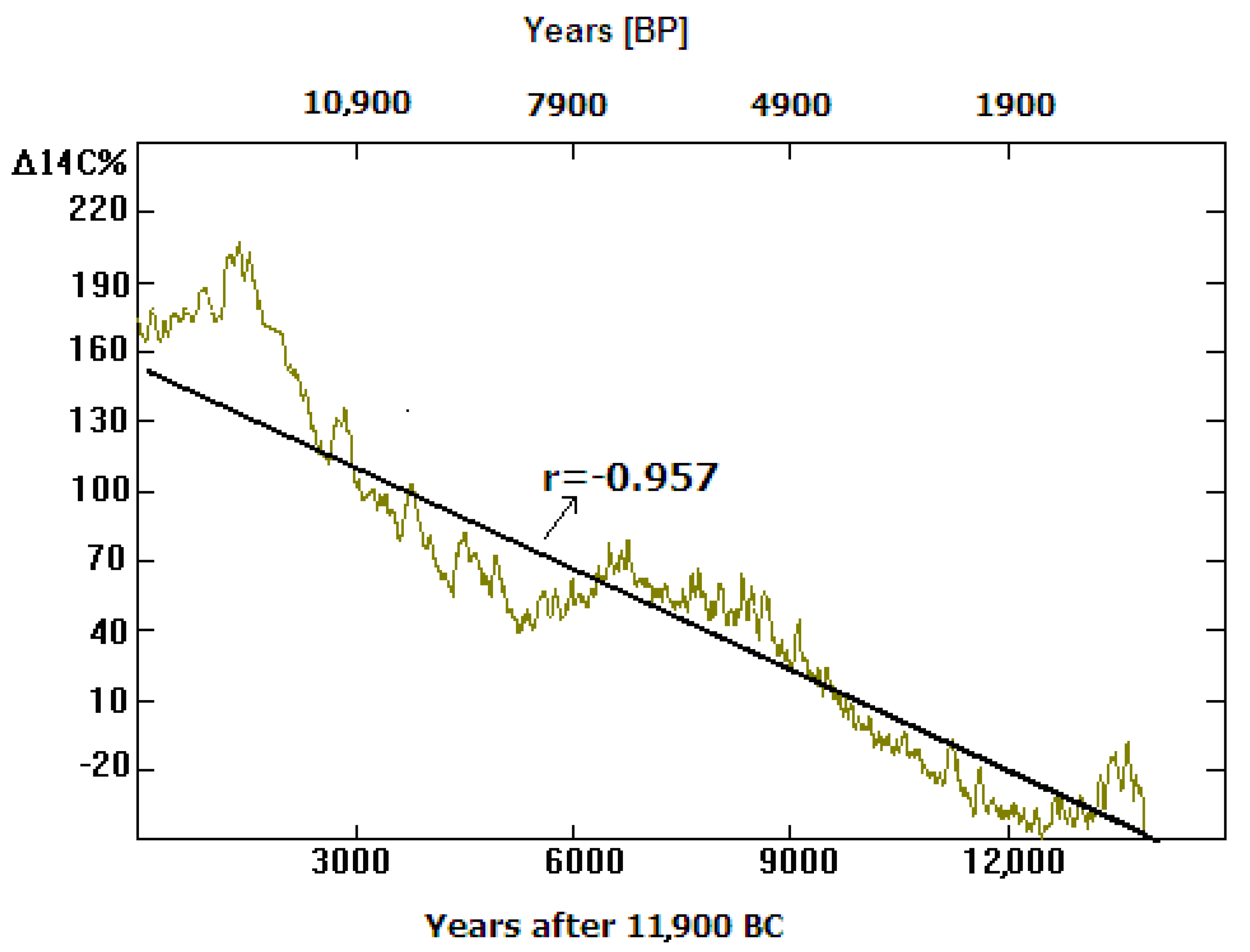
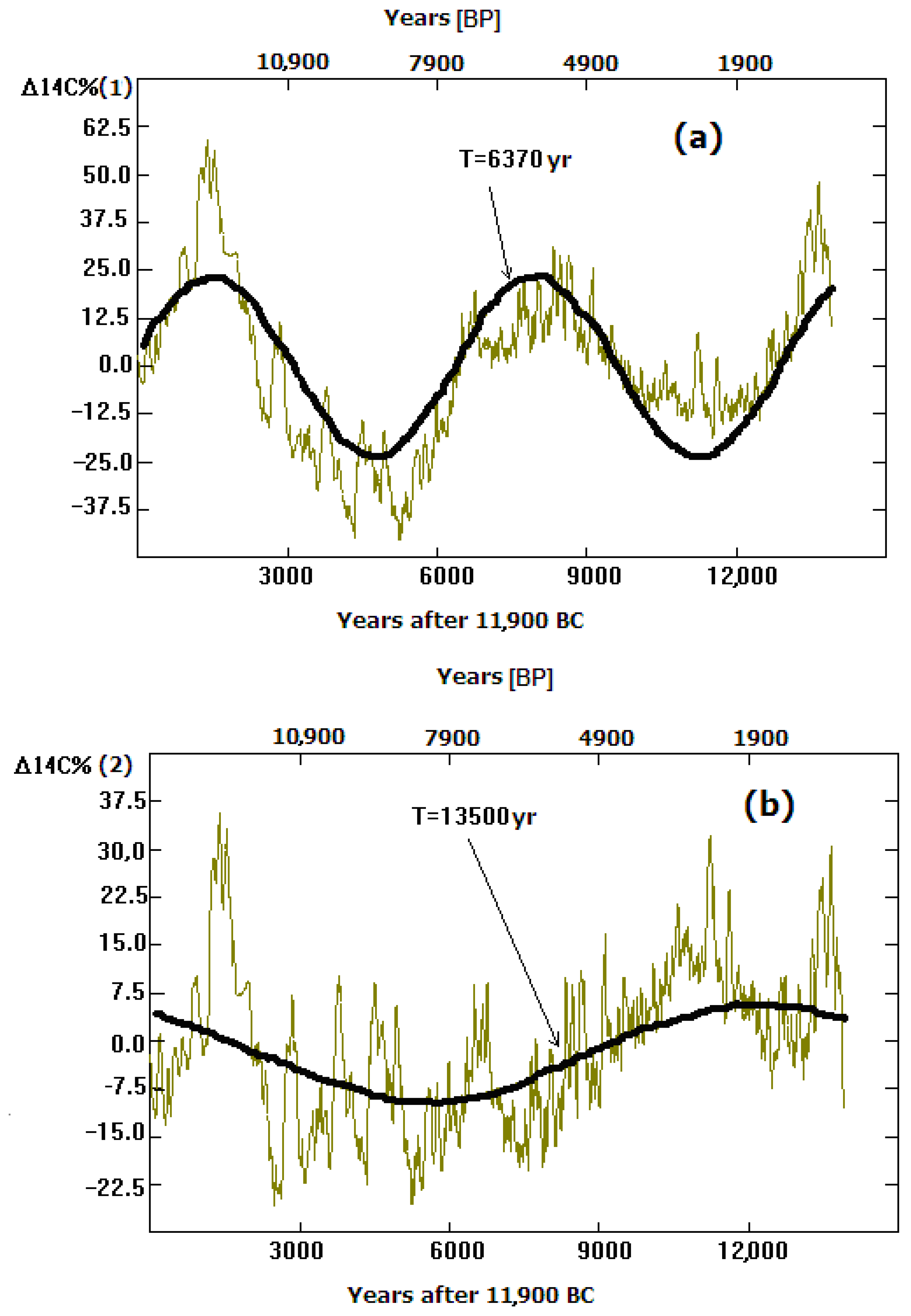
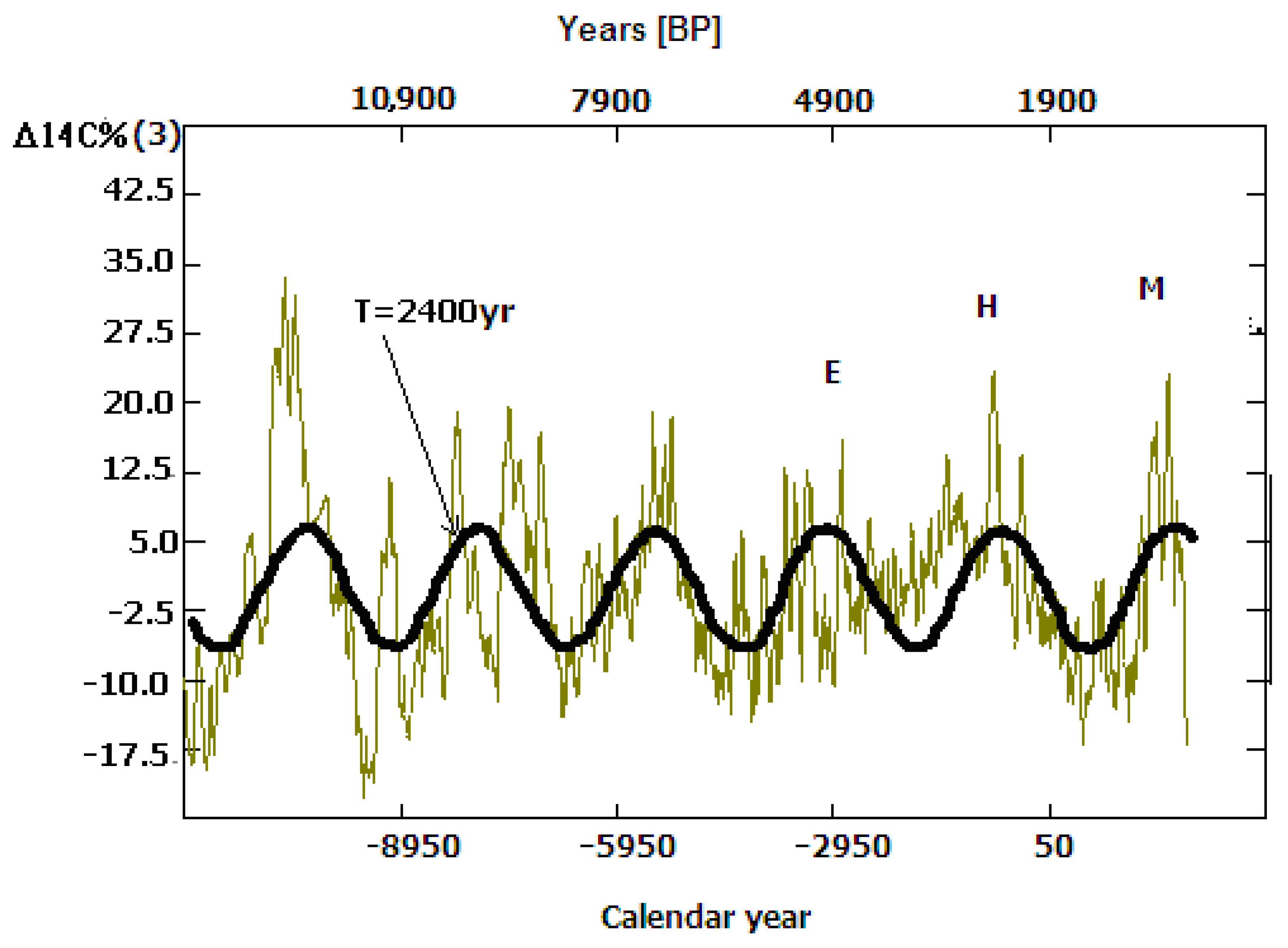
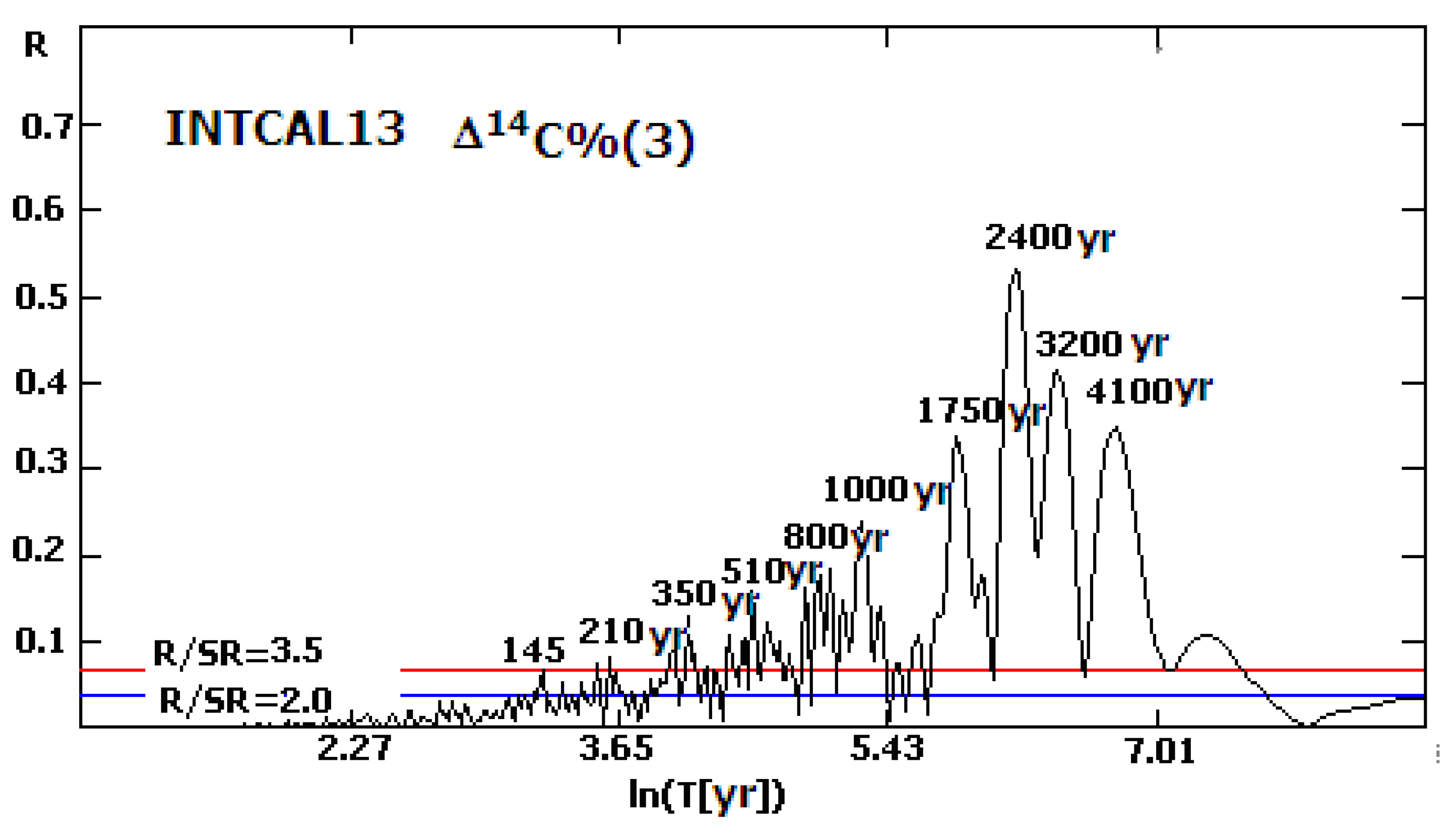
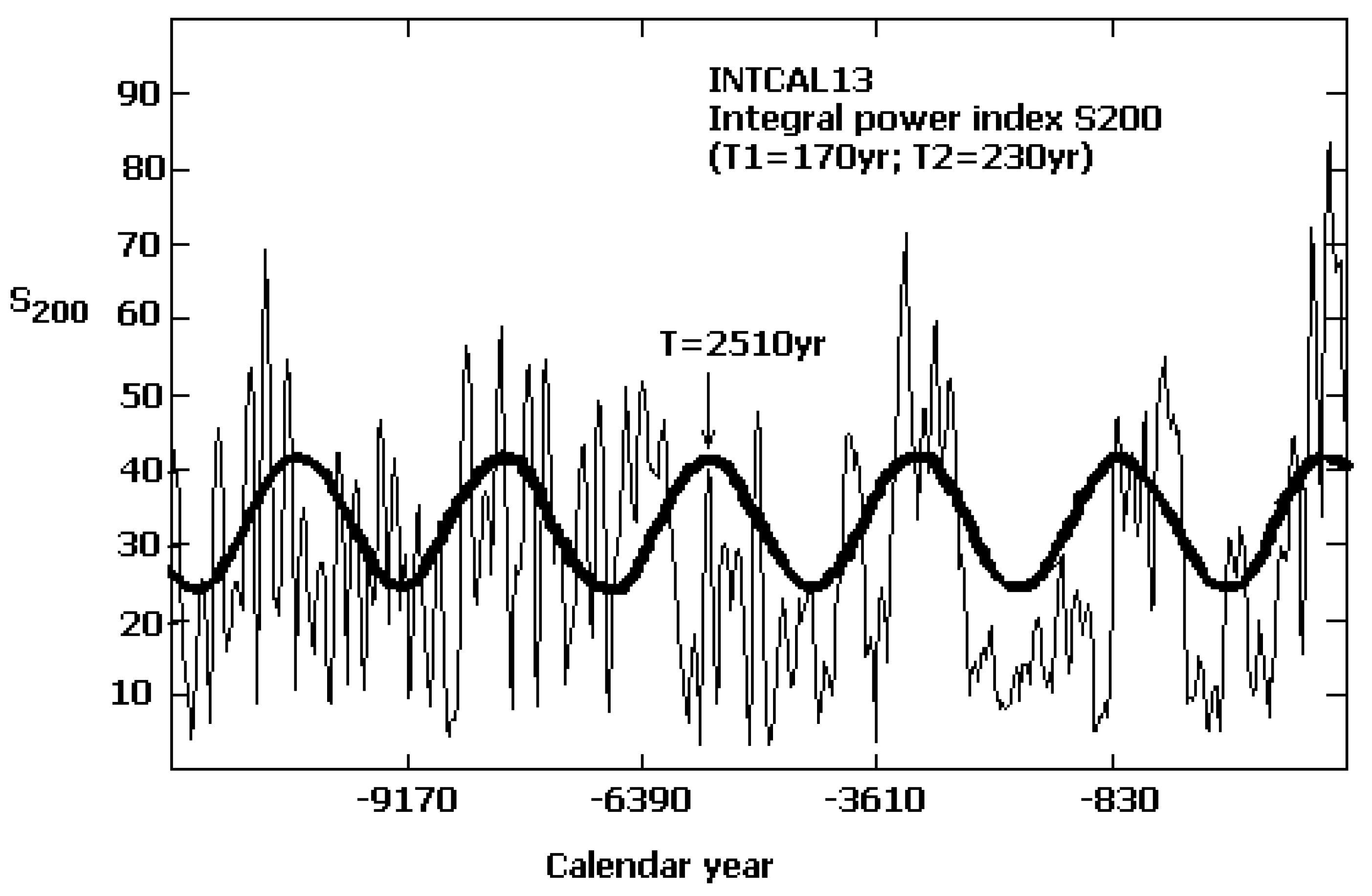
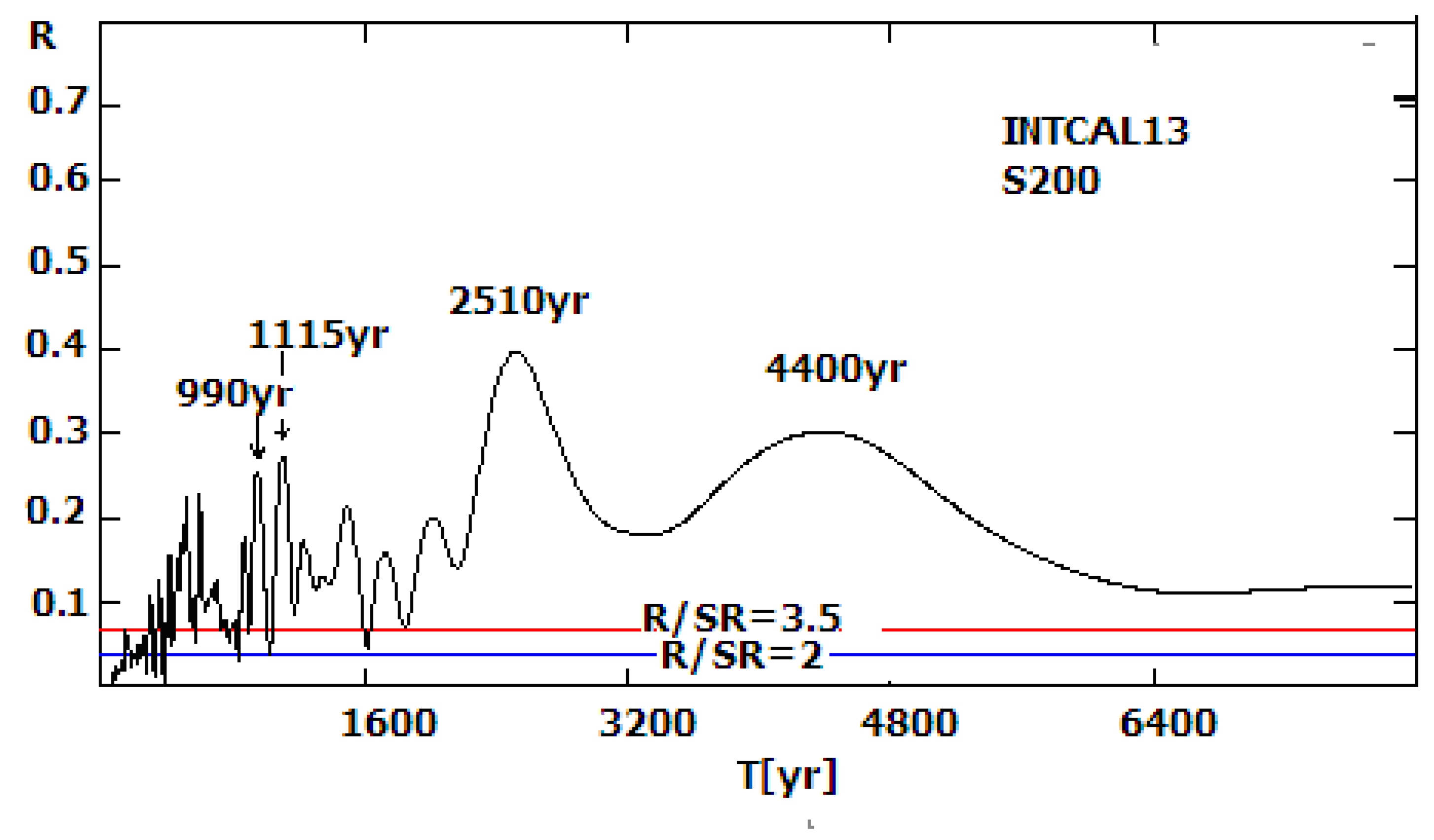

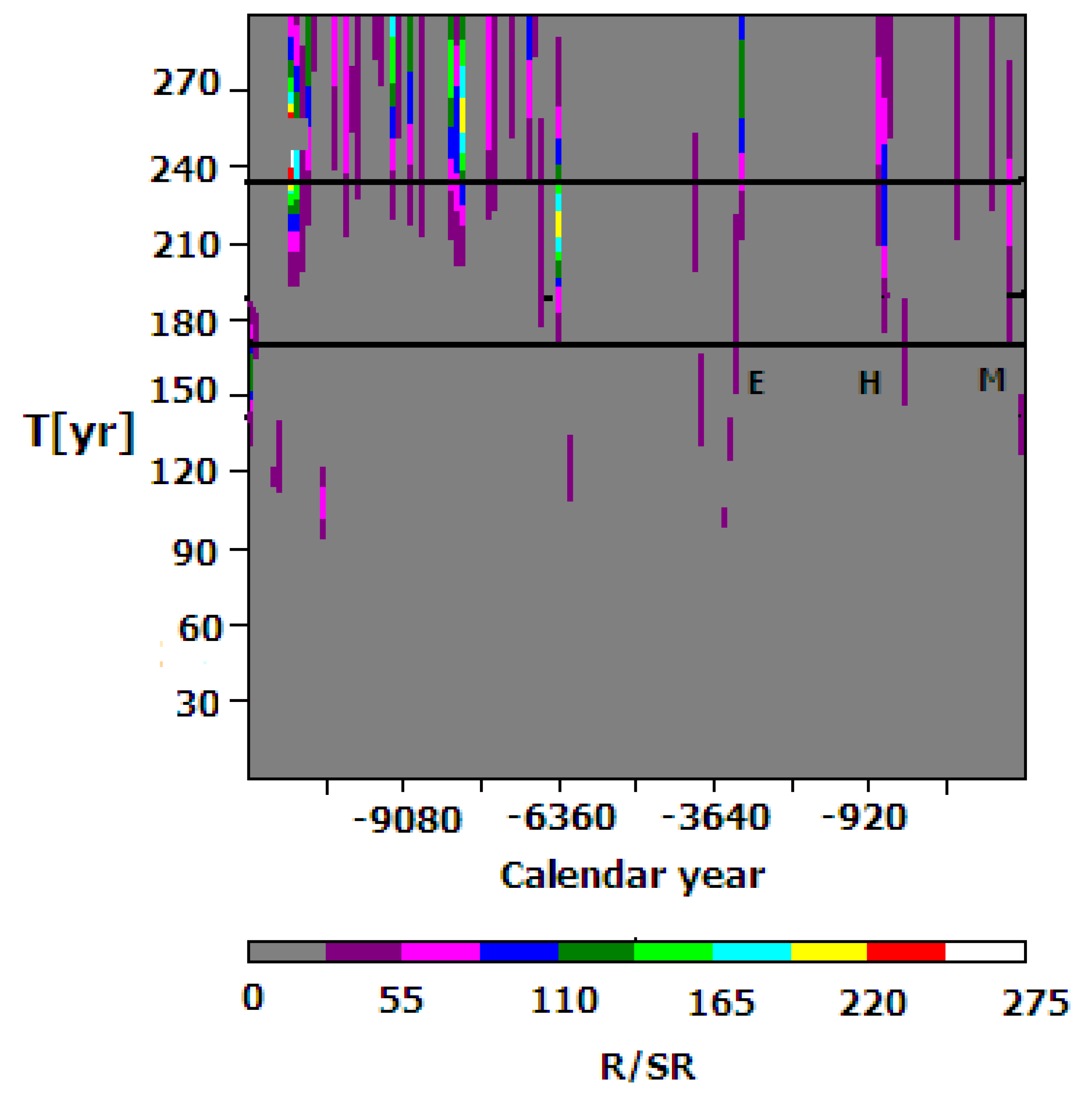
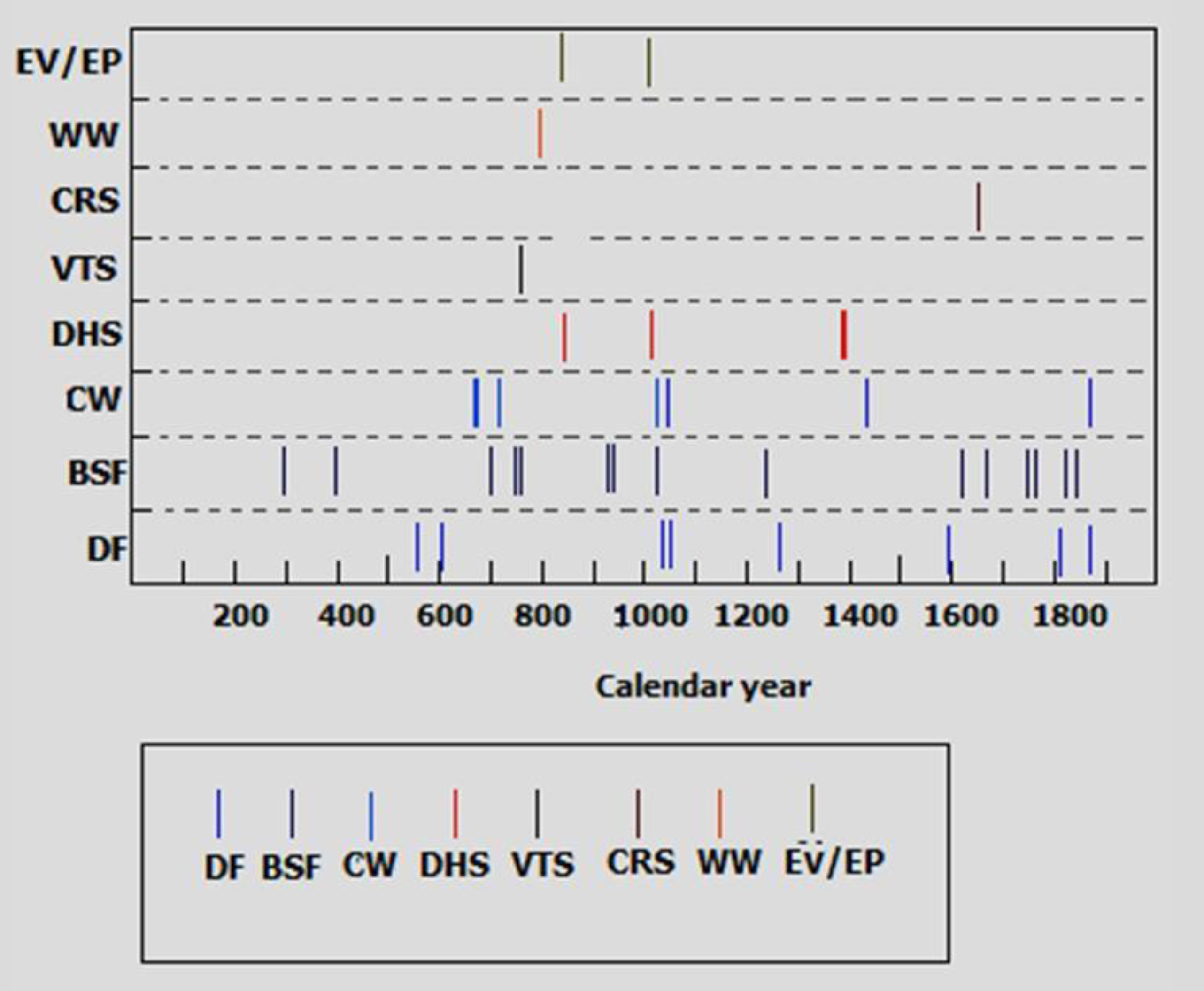
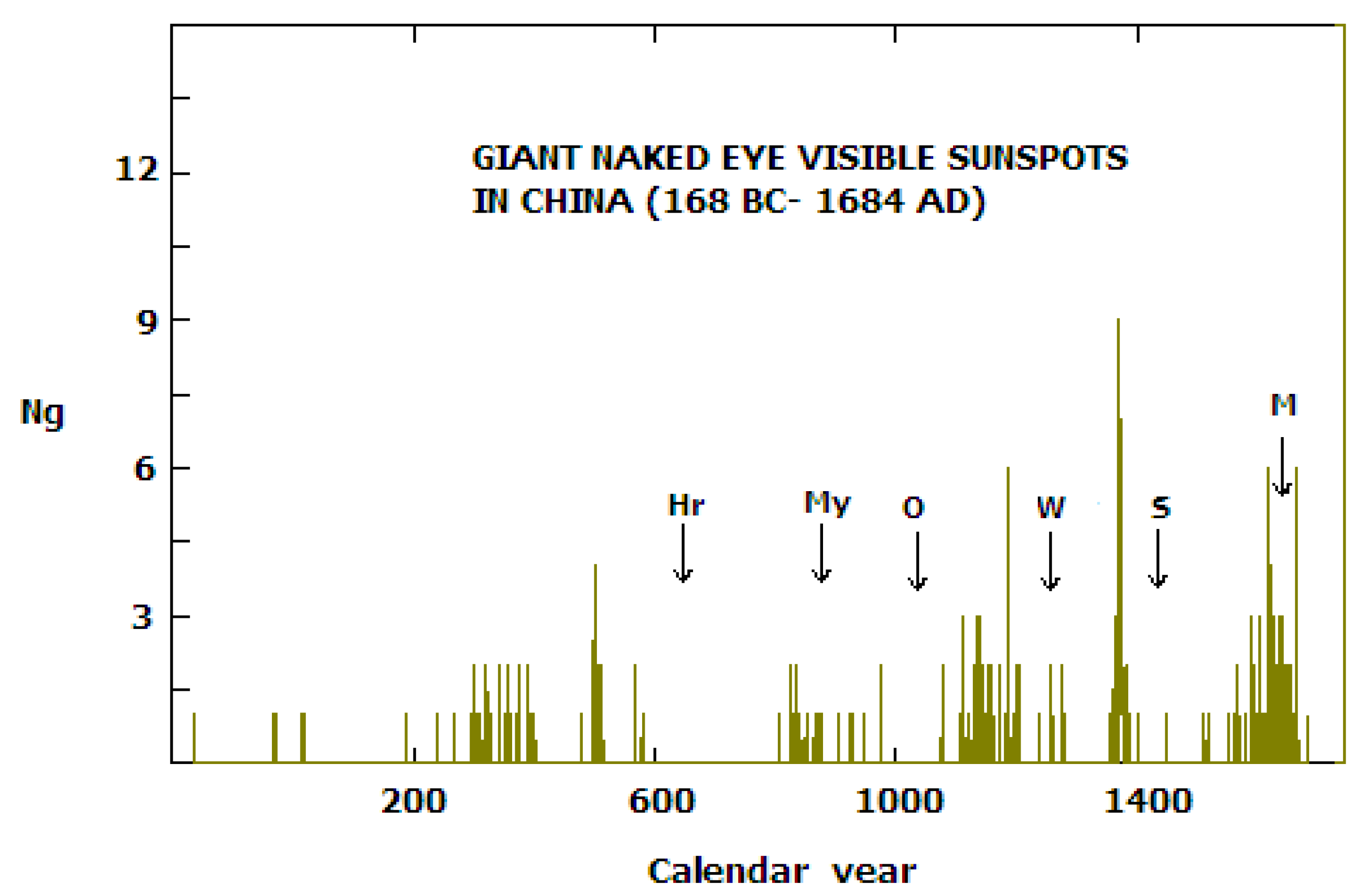
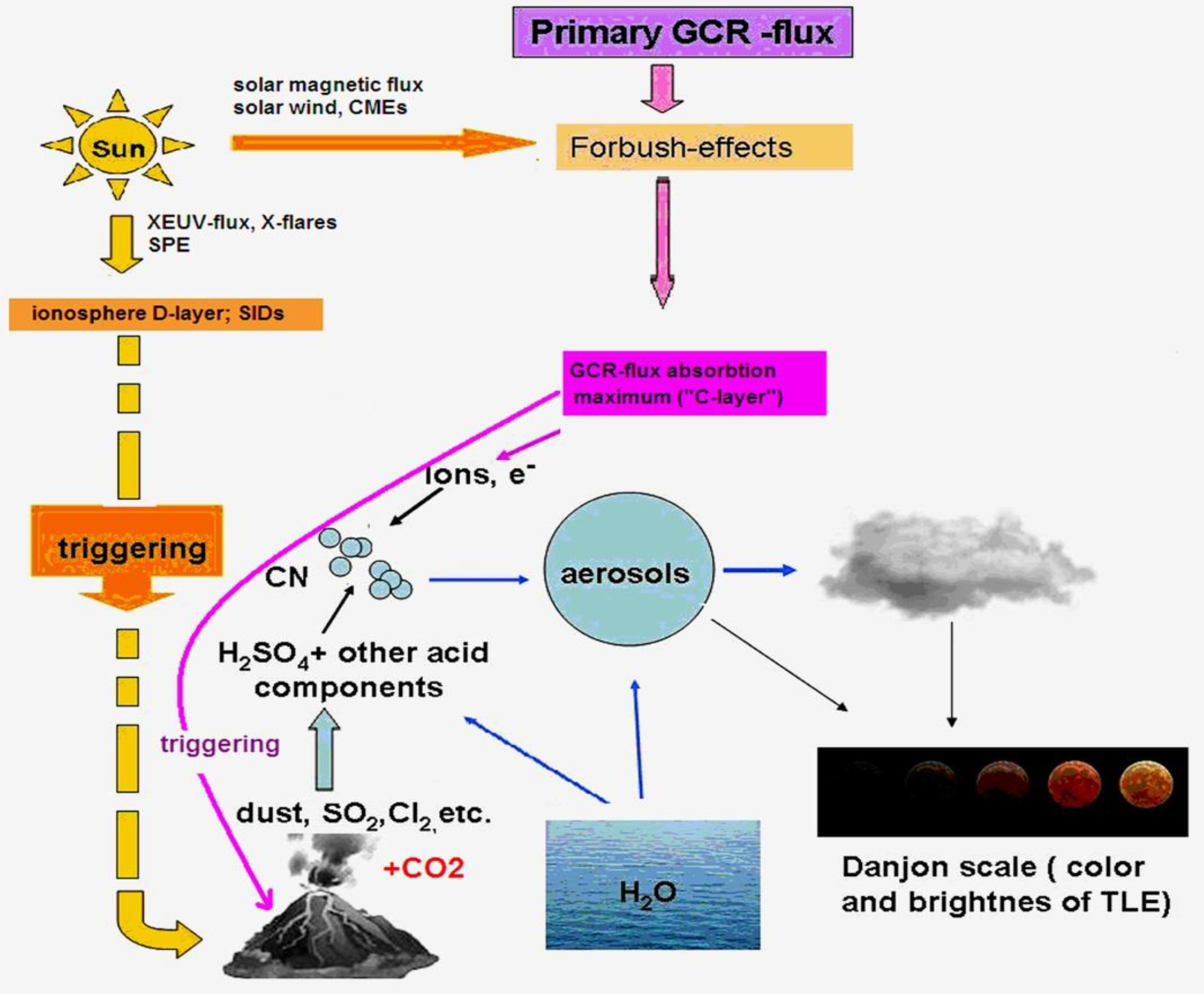
| Year | Type of Event | SHC | Year of Sunspot Cycle Minimum (m) | Year of Sunspot Cycle Maximum (M) | L [yr] | Δm [yr] | ΔM [yr] | Wmax |
|---|---|---|---|---|---|---|---|---|
| 299 | BSF | 1 | 296 | 301 | 11 | +3 | −2 | 145 |
| 400 | BSF | 10 | 391 | 396 | 13 | +9 | +4 | 85 |
| 558 | DF | 24 | 551 | 556 | 11 | +7 | +2 | 85 |
| 602 | DF | 29 | 602 | 607 | 11 | 0 | −5 | 60 |
| 678 | CW | 35 | 671 | 673 | 13 | +7 | +5 | 120 |
| 679 | CW | 35 | 671 | 673 | 13 | +8 | +6 | 120 |
| 703 | BSF | 37 | 693 | 699 | 14 | +10 | +4 | 60 |
| 717 | VCW | 38 | 707 | 714 | 12 | +10 | +3 | 120 |
| 755 | BSF | 42 | 749 | 754 | 12 | +5 | +1 | 85 |
| 765 | BSF | 43 | 761 | 763 | 9 | +4 | +2 | 145 |
| 774 | VTS | 44 | 770 | 777 | 12 | +4 | −3 | 100 |
| 814 | WW | 47 | 804 | 806 | 11 | +10 | +8 | 120 |
| 863 | DHS + EQ | 52 | 856 | 861 | 12 | +6 | +2 | 100 |
| 928 | BSF | 58 | 921 | 925 | 13 | +7 | +3 | 145 |
| 934 | BSF | 59 | 934 | 937 | 11 | 0 | −3 | 100 |
| 1028 | BSF + C W | 67 | 1022 | 1028 | 12 | 6 | 0 | 85 |
| 1035 | DF | 68 | 1034 | 1041 | 13 | 0 | −7 | 60 |
| 1037 | WW + E Q + EP + CRS | 68 | 1034 | 1041 | 13 | +3 | −4 | 60 |
| 1048 | DF + C W | 69 | 1047 | 1054 | 13 | +1 | −6 | 50 |
| 1242 | BSF | 86 | 1233 | 1239 | 11 | +9 | +3 | 85 |
| 1268 | DF | 88 | 1256 | 1261 | 13 | +12 | +7 | 85 |
| 1388 | DHS | 100 | 1386 | 1391 | 10 | +2 | −3 | 85 |
| 1391 | DHS | 100 | 1386 | 1391 | 10 | +5 | 0 | 85 |
| 1443 | CW | 105 | 1443 | 1450 | 11 | 0 | −7 | 70 |
| 1620 | BSF | 121 | 1620 | 1625 | 13 | 0 | −5 | 115 |
| 1668 | CRS | 125 | 1666 | 1673 | 13 | +2 | −5 | 35 |
| 1669 | BSF | 125 | 1666 | 1673 | 13 | +3 | −4 | 35 |
| 1755 | BSF | 133 | 1755 | 1761 | 11 | 0 | −6 | 86.5 |
| 1774 | BSF | 134 | 1766 | 1769 | 9 | +8 | +5 | 115.8 |
| 1810 | DF | 138 | 1810 | 1816 | 13 | 0 | −6 | 48.7 |
| 1823 | BSF | 139 | 1823 | 1829 | 10 | 0 | −6 | 71.7 |
| 1850 | BSF | 141 | 1843 | 1848 | 13 | +7 | +2 | 131.6 |
| 1876 | DF | 143 | 1867 | 1870 | 12 | +9 | +6 | 140.5 |
| 1878 | CW | 143 | 1867 | 1870 | 12 | +11 | +8 | 140.5 |
| 1902 | DF | 146 | 1901 | 1907 | 12 | +1 | −5 | 64.2 |
| 1904 | BSF | 146 | 1901 | 1907 | 12 | +3 | −3 | 64.2 |
| 1905 | DF | 146 | 1901 | 1907 | 12 | +4 | −2 | 64.2 |
| 1929 | DF + BS F | 148 | 1923 | 1928 | 10 | +6 | +1 | 78.1 |
| 1932 | CW | 148 | 1923 | 1928 | 10 | +10 | +4 | 78.1 |
| 1942 | DF | 149 | 1933 | 1937 | 11 | +9 | +5 | 119.2 |
| 1949 | DF | 150 | 1944 | 1947 | 10 | +5 | +2 | 151.8 |
| 1954 | DF + BS F | 151 | 1954 | 1957 | 10 | 0 | −3 | 201.3 |
| 1963 | DF + BS F | 151 | 1954 | 1957 | 10 | +9 | +6 | 201.3 |
| 1985 | DF | 153 | 1976 | 1979 | 10 | +9 | +6 | 184.5 |
| 2002 | DF | 155 | 1996 | 2000 | 12 | +6 | +2 | 120.8 |
Disclaimer/Publisher’s Note: The statements, opinions and data contained in all publications are solely those of the individual author(s) and contributor(s) and not of MDPI and/or the editor(s). MDPI and/or the editor(s) disclaim responsibility for any injury to people or property resulting from any ideas, methods, instructions or products referred to in the content. |
© 2024 by the author. Licensee MDPI, Basel, Switzerland. This article is an open access article distributed under the terms and conditions of the Creative Commons Attribution (CC BY) license (https://creativecommons.org/licenses/by/4.0/).
Share and Cite
Komitov, B. About the Possible Solar Nature of the ~200 yr (de Vries/Suess) and ~2000–2500 yr (Hallstadt) Cycles and Their Influences on the Earth’s Climate: The Role of Solar-Triggered Tectonic Processes in General “Sun–Climate” Relationship. Atmosphere 2024, 15, 612. https://doi.org/10.3390/atmos15050612
Komitov B. About the Possible Solar Nature of the ~200 yr (de Vries/Suess) and ~2000–2500 yr (Hallstadt) Cycles and Their Influences on the Earth’s Climate: The Role of Solar-Triggered Tectonic Processes in General “Sun–Climate” Relationship. Atmosphere. 2024; 15(5):612. https://doi.org/10.3390/atmos15050612
Chicago/Turabian StyleKomitov, Boris. 2024. "About the Possible Solar Nature of the ~200 yr (de Vries/Suess) and ~2000–2500 yr (Hallstadt) Cycles and Their Influences on the Earth’s Climate: The Role of Solar-Triggered Tectonic Processes in General “Sun–Climate” Relationship" Atmosphere 15, no. 5: 612. https://doi.org/10.3390/atmos15050612
APA StyleKomitov, B. (2024). About the Possible Solar Nature of the ~200 yr (de Vries/Suess) and ~2000–2500 yr (Hallstadt) Cycles and Their Influences on the Earth’s Climate: The Role of Solar-Triggered Tectonic Processes in General “Sun–Climate” Relationship. Atmosphere, 15(5), 612. https://doi.org/10.3390/atmos15050612





